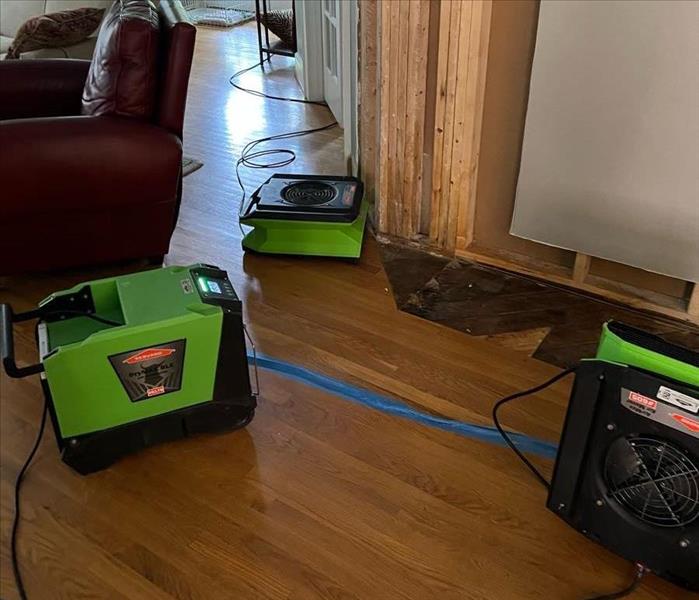How to Navigate The Aftermath of Storm Damage
1/2/2024 (Permalink)
 In this blog, we'll explore crucial steps to manage storm damage and immediate actions to take following a weather event.
In this blog, we'll explore crucial steps to manage storm damage and immediate actions to take following a weather event.
When severe weather strikes North Carolina, homes are vulnerable to various forms of damage—wind damage, flooding, and roof leaks among them. As specialists in storm damage restoration, SERVPRO® recognizes the challenges homeowners face post-storm. In this blog, we'll explore crucial steps to manage storm damage and immediate actions to take following a weather event.
Understanding Common Types of Storm Damage
Severe weather can lead to:
Wind Damage: High winds can cause structural harm, broken windows, and roof issues that may result in water entering the home.
Flooding: Heavy rainfall or storm surges can induce flooding, impacting basements, crawl spaces, and interior spaces.
Roof Leaks: Damaged or missing shingles can cause leaks, permitting water to infiltrate the home and cause additional damage.
Immediate Actions After a Storm
- Check for hazards like downed power lines, unstable structures, or gas leaks. Avoid standing water, which may hide potential dangers.
- Thoroughly inspect your property for visible damage and document it through photos or videos to support insurance claims.
- Report storm damage to your insurance provider to initiate the claims process as quickly as possible. Remember to keep records of all communications and claim details.
The Importance of Professional Restoration Services
Seek professional restoration services like SERVPRO of Harnett County West immediately after the storm. Our rapid response can prevent further damage and kick-start restoration promptly. Our trained professionals conduct thorough assessments, providing detailed documentation to support insurance claims and guide restoration. SERVPRO® utilizes advanced equipment for water extraction, drying, and structural repairs, ensuring a comprehensive restoration process.
Handling storm damage can be challenging, but timely and informed actions are crucial. Prioritize safety, document damage, contact insurers promptly, and engage professional restoration services like SERVPRO of Harnett County West to navigate the aftermath of storms effectively. Contact us today for prompt and reliable service!
The Aftermath of Storm Surge and Flood Damage: Steps for Recovery
9/25/2023 (Permalink)
Storm surge and flooding can have devastating effects on homes and communities. The aftermath of such events can be overwhelming, but with the right approach and guidance, you can begin the process of recovery and restoration. In this blog post, we will explore the steps to take in the aftermath of storm surge and flood damage to help you navigate the recovery process effectively.
Ensure Safety First
The safety of yourself and your family is of utmost importance. Before entering your property, ensure that it is safe to do so. Check for any structural damage, electrical hazards, or compromised utilities like gas lines. If there are safety concerns, contact local authorities or professionals to assess the situation before entering.
Document the Damage
Documenting the extent of the damage is essential for insurance claims and the recovery process. Take photographs or videos of the affected areas, making sure to capture any damaged structures, belongings, or valuables. Keep a detailed inventory of all damaged items, including their approximate value and purchase date if possible. This documentation will be valuable when negotiating with insurance companies or applying for assistance.
Contact your insurance company as soon as possible to report the damage and start the claims process. Provide them with the necessary documentation and any additional information they may require. Keep track of all communication with your insurance provider, including dates, names, and any relevant claim numbers. Be patient, as the claims process may take time, especially during times of widespread destruction.
Begin Cleanup and Restoration
Once you've ensured your safety and documented the damage, it's time to begin the cleanup and restoration process. It is highly recommended to hire professional restoration services experienced in flood damage cleanup. They have the expertise, equipment, and knowledge to handle the necessary tasks safely and efficiently.
Remove any standing water from your property using pumps, wet vacuums, or other appropriate equipment. Thoroughly dry out affected areas to prevent further damage and mold damage. Dispose of damaged, contaminated, or unsalvageable items properly, following local regulations.
Mitigate Further Damage
During the reconstruction and restoration phase, it's important to take steps to mitigate any further damage. This may involve implementing measures such as covering damaged areas, boarding up broken windows, or temporarily sealing any openings to protect against rain, wind, or potential intruders.
Recovering from storm surge and flood damage can be a complex process. Consider seeking professional assistance from contractors, flood damage specialists, or disaster relief organizations. They can provide expert guidance, help with the restoration process, and advise on potential hazards or future preventive measures.
Plan for Future Resilience
After experiencing storm surge and flood damage, it's essential to plan for future resilience. Consult with professionals, such as architects or engineers, to assess your property's vulnerability and explore preventive measures. Consider elevating utilities and structures, installing flood barriers or seals, or landscaping with flood-resistant plants. Understand local zoning regulations and building codes to ensure any future improvements adhere to the appropriate guidelines. Recovering from storm surge and flood damage can be a challenging and emotionally draining process. Remember to be patient, as recovery takes time, but with perseverance, you can rebuild and restore your home.
 In this blog, we'll explore crucial steps to manage storm damage and immediate actions to take following a weather event.
In this blog, we'll explore crucial steps to manage storm damage and immediate actions to take following a weather event.

 24/7 Emergency Service
24/7 Emergency Service